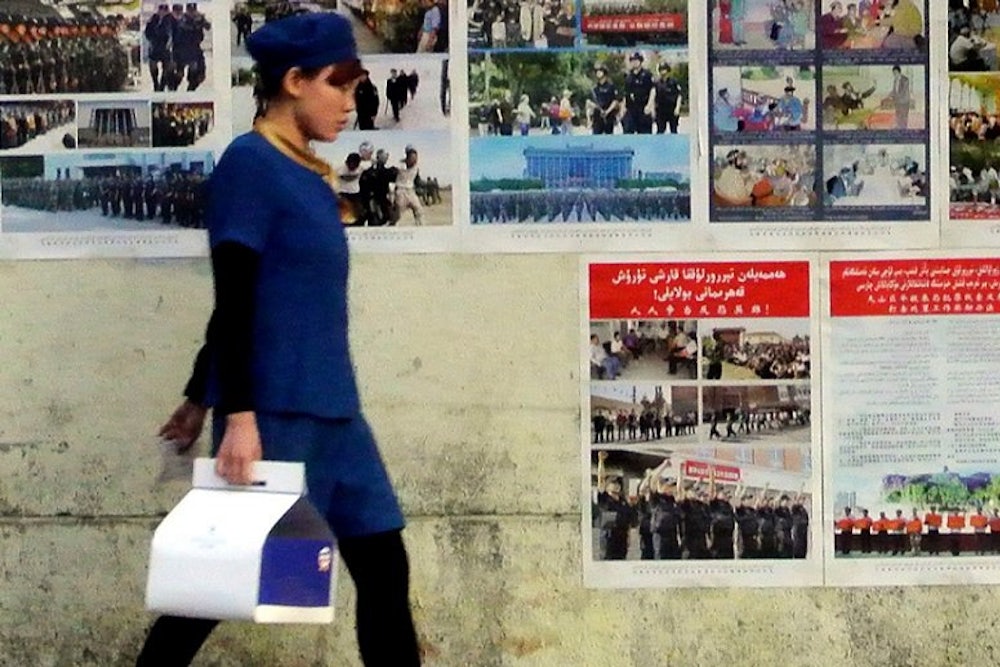On January 10, the day 1.5 million people filled Paris's streets in solidarity against the terror attacks in that city, China’s official Xinhua news service published a self-serving editorial arguing that France’s free-wheeling media abetted the attack.
“The world is diverse and there should be limits on press freedom,” read the editorial by Paris bureau chief Ying Qiang. “Unfettered and unprincipled satire, humiliation, and free speech are not acceptable.”
Such a remark is par for the course for China’s state media, which rarely miss an opportunity, no matter how distasteful, to trumpet the Communist Party line. But, pointedly, the Paris attacks on the satirical Charlie Hebdo and on a kosher supermarket resonated with recent events in China. Over the past year, clashes between China’s majority Han and its ethnic Uighur population have escalated. On Monday, a government website located in Xinjiang reported that police killed six Uighur men who had attacked them with axes. And in September, following explosions that killed six police in Xinjiang, an ensuing riot led to police killing 40 people. Most spectacularly, masked militants armed with swords and knives entered a train station in Kunming, a regional capital in southwest China, and stabbed 30 people to death.
The perpetrators of the Paris attacks were French-born of Islamic origin, part of the country’s five-million-strong Muslims who have struggled to assimilate into French society while maintaining their cultural heritage. The French government famously restricts when and where French women can wear headscarves, a regulation that critics claim robs the country’s minority population of their identity. Likewise, the Chinese government has imposed similar restrictions on Islamic dress among its Uighur population, most recently by banning full-length burqas in Urumqi, Xinjiang’s capital city. The ban followed a similar restriction imposed in Karamay, a smaller Xinjiang city, that forbids religious wear on public transportation.
But China's repression of its Uighur population goes well beyond similar French measures. Officials in Xinjiang have placed the Chinese flag inside mosques throughout the region, and have restricted many faithful (including children under the age of 18) from entering mosques at all. The Chinese government has also clamped down on bilingual education in the region, placing Uighur people—for whom Mandarin is not a first language—at a competitive disadvantage. “A lot of ethnic minorities in Xinjiang, as in Tibet, feel that the Chinese government is practicing a form of cultural genocide,” said Julia Famularo, an expert in the region at Project 2049, a think tank in Washington, D.C.
The Chinese government’s strategy in Xinjiang is driven by economic strategy. Alaska-sized and bordering eight sovereign states, Xinjiang is vital to China’s burgeoning relationship with the countries to its west, with whom Beijing has signed long-term energy contracts. To spur the domestic economy, China has invested billions in fixed-asset infrastructure throughout the region, including a high-speed train linking Urumqi to Lanzhou, a regional capital to the east.
These investments have brought considerable wealth to Xinjiang. But China’s Uighurs insist that they’re largely shut out. Once the majority ethnicity in Xinjiang, the Uighur share of the population has dropped steadily since 1950, when Mao and the People’s Liberation Army incorporated the territory into the fledgling People’s Republic. In Urumqi, a city of 3 million people, just 10 percent are Uighur. The rest, mainly internal migrants from China’s Han majority, completely dominate the city’s government, economy, and security forces. And as in Paris, whose Muslim population resides primarily in banlieues on the outskirts of the cities, China’s Uighur and Han populations are highly segregated.
The result is cultural and economic isolation for the Uighurs. With increasing frequency, they have turned to terrorist violence. The Chinese government has long blamed outside extremist groups, including a shadowy organization called the East Turkestan Islamic Movement (ETIM) that Beijing claims gets money and support from militants based in Afghanistan and Pakistan. Given the absence of reliable coverage of the region, assessing the influence of groups like ETIM—whose very existence has been questioned—is difficult. “There are definitely organized groups tied to the wider Islamist ideology,” said James Palmer, a Beijing-based writer who has studied the region extensively. “But there’s a large dose of local nationalism.” The combination has fed radical ideas in the region. Palmer added: “Uighur videos online are increasingly using jihadist terms."
On this point, China's state media is correct: China’s Uighurs and France’s Muslims differ in their access to free speech. Even by Chinese standards, the situation in Xinjiang, where foreign journalists are often barred from visiting, is especially severe. “In France, there are plenty of mechanisms by which Muslims can express themselves in public,” says Famularo. “In China there aren’t.” After large-scale riots in Urumqi claimed almost 200 lives in 2009, China shut off Internet access throughout the region for six months.
France’s protection of free speech—epitomized by Charlie Hebdo's audacity—has exacerbated tensions among varying ethnic groups there. Yet the country’s openness also allows marginalized communities to have a voice. Just don't expect China's state media to acknowledge the point.
